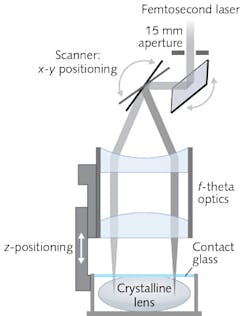Ophthalmology/Femtosecond Lasers: 'Especially gentle' ultrafast laser treatment targets presbyopia

Excimer-laser-assisted in situ keratomileusis (LASIK) is well established for vision correction, and more recently, femtosecond lasers have been used for cataract surgery. Now, ultrafast lasers are targeting presbyopia—the farsightedness resulting from stiffness in the ocular lens that commonly affects people 40 and older. Laser Zentrum Hannover (LZH; Germany) is leading efforts to research and develop laser treatment to restore flexibility to the eye's natural crystalline lens. As part of a now-concluded three-year project called IKARUS, the nonprofit research institute and its commercial partners developed a femtosecond-lentotomy method based on nonlinear interaction of ultrafast laser pulses and tissue.
The nonlinear photodisruption effect allowed etching of micro-incisions inside the lens, without opening the eye globe, to produce 3D structures. The laser cut two concentric cylinders in the depth direction of the lens, annular rings on each end, and 12 radial incisions. This pattern creates slip-planes that enable restoration of dynamic adjustment between far and near vision.1 The researchers used optical coherence tomography (OCT) to monitor the procedure.
Virtual model, experimentation
In a follow-on two-year project, LZH is working with partners to create a virtual model to simulate the "especially gentle" surgery, so called because the tightly focused, ultrashort pulses (100–500 fs, depending on the system) of 1040 nm light minimize damage to surrounding tissue. This latest project (Ray tracing in ophthalmic finite element models for predicting of visual acuity enhancement, or RayFEye) uses an experimental setup to simulate the different focal distances by stretching and unstretching a sample porcine crystalline lens. The setup precisely measures the impact of the cuts by monitoring changes in the optical beam path (ray tracing) through the lens both before and after cutting.
The researchers will use ray photography and wavefront measurements to test the validity of the simulation experimentally. And, they will develop software to predict visual outcomes for patients of ophthalmic refractive surgery-including both astigmatic keratotomy (removal of part of the cornea) and the crystalline lens etching. These experiments aim to determine and optimize cutting patterns that can be loaded into software to allow practice on a lens model prior to surgery. Alexander Krüger, head of the Image-Guided Laser Surgery Group at LZH, says, "We do not know yet if there is a 'one size fits all' pattern," or whether patterns will need to be customized for patients. "This is one reason why we started the computer tissue mechanics simulation and ray-tracing approach."
Ultimately, RayFEye aims to make femtosecond-lentotomy results predictable. Further development will customize the software for clinical use.
The IKARUS project involved German partners Rowiak GmbH (Hannover) as laser system manufacturer, Qioptiq Photonics GmbH & Co. KG (Göttingen) as optics designer, Arges GmbH (Wackersdorf) for laser scanner systems, and the Laserforum Köln e.V. (Cologne) for clinical consulting and eye measurement. The project was supported by the German Federal Ministry of Education and Research (BMBF). RayFEye involves Rowiak along with software developer Optimo Medical AG—its work is supported by BMBF and the Swiss State Secretariat for Education, Research and Innovation (SBFI) within the framework of the Eurostars program.
REFERENCE
1. S. Schumacher and U. Oberheide, "Femtosecond Lentotomy: A Prospect for a Treatment to Regain the Accommodation Ability," Ultrashort Pulse Laser Technology, Springer, 285–309 (2015).
About the Author

Barbara Gefvert
Editor-in-Chief, BioOptics World (2008-2020)
Barbara G. Gefvert has been a science and technology editor and writer since 1987, and served as editor in chief on multiple publications, including Sensors magazine for nearly a decade.